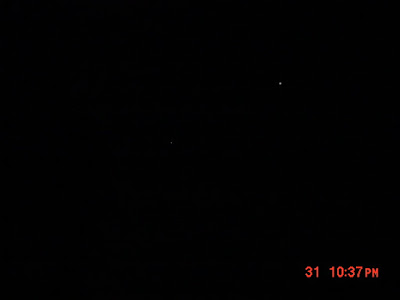 My very first true astrophoto, taken May 31, 2005
My very first true astrophoto, taken May 31, 2005For anyone who has even just breezed through this website while randomly surfing around, it should be readily apparent that I am an astrophotographer, just look at all the images (there are actually many, many more than posted, but to get them all here would take a year)! When it comes to shooting the stars, I am anything but alone in the pursuit of what is, for many, a lifelong obsession. While being an astropgotographer is anything but unique, how many astrophotographers can say exactly, where, when, and how it all began? Probably not many.
It was exactly 5 years ago today (at 9:42pm EDT to be specific) that I took what rightly can be called my first true astrophoto. Sure, I'd gotten pictures of the Moon before, buy anyone with any camera can do that, no special skill required. These were my first astro shots requiring special knowledge.
It was Tuesday, May 31, 2005. I was finishing up high school, and I was in a journalism class and had signed out one of the cameras (to cover what, I don't remember). That night I decided to turn the camera toward the stars. I had been reading up on astrophotography (of the film variety) for quite some time, however, I didn't have any camera besides an instant Polaroid at the time. Rats! So, knowing that this was probably my last chance to get my hands on a real camera for the foreseeable future, it was now or never to try some astrophotography.
The camera was an ancient (even in 2005) Sony Mavica, circa 2000. Long relegated to the bargain bin at local camera stores (and maybe to the garbage bin in the near future now that Sony is stopping production of floppy discs, which is this camera's storage medium), in their time, the big 14x zoom Mavicas set the standard for serious digital cameras. It was time to see what kind of astro cam one would be (it only had a 2 second minimum shutter speed).
Heading out into the driveway with the tripod, I set my sight on the brightest thing in the sky that night, Jupiter, then in the constellation of Virgo. The camera went on the tripod, I equipped the self-timer, zoomed in somewhat, focused on a far away light, then swung up the camera toward the king of the planets. The camera took the picture and sure enough, upon playback, Jupiter was captured as a perfect dot with two stars, Porrima (left) and Zaniah (right).
This was cool!
Not content with just Jupiter, I set my sights on some other celestial targets. Keeping with Jupiter, I zoomed in all the way and tried another shot. Much to my amazement, some of Jupiter's moons came out in the picture! Despite being my one of my first photos, this is still a favorite.
Before the night was out, I finished up by snagging Jupiter and Spica, Vega and Deneb, and lastly, Saturn with Pollux and Castor just above some shrubbery as they sat in the West. As a last astrophoto, I also managed to get the waning crescent Moon as I was getting dropped off for school the next morning.
Looking back, these photos are nothing in terms of technical quality, but everyone has to start somewhere and this is where I started five years, and thousands of photos ago.
 Jupiter and Moons
Jupiter and MoonsIf you found this informative (or at least entertaining), check out my Examiner page for more great stuff. By doing this, you are helping me pay the bills, which I am grateful for.
Don't forget to pass this link along, either.
For something even better, become a follower.



















No comments:
Post a Comment